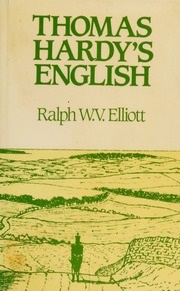
- Free Article: No
- Contents Category: Literary Studies
- Review Article: Yes
- Article Title: Bad, But Sublime
- Article Subtitle: Choosing your words carefully
- Online Only: No
- Custom Highlight Text:
Confronted with a tide like Thomas Hardy’s English the reviewer is likely to exclaim waspishly ‘I know that!’, but any tendency towards frivolity disappears once one begins to read this book. This is an extraordinarily thorough, exhaustive and illuminating study of the amazingly varied resources Hardy drew on for his language. The book is part of a series known as The Language Library and it is the specifics of Hardy’ s actual use of words that Professor Elliott, now Emeritus Professor and Master of University house at the Australian National University, is concerned with.
- Book 1 Title: Thomas Hardy's English
- Book 1 Biblio: Allen & Unwin, $48.50, 388pp
- Book 1 Cover (800 x 1200):

He shows that Hardy’s vocabulary was shaped by the unusually diverse elements in his background, the ‘three strands’ of his professional life as an architect, the rustic life of his boyhood and adolescence spent in the Dorsetshire countryside, and perhaps most importantly and controversially the scholar’s life, the life of an extraordinarily omnivorous reader. Elliott believes – and argues persuasively – that the overwhelming impulse behind Hardy’s choice of language was the need to maintain and preserve continuities with the past. Hence his selective use of dialectical words often of ancient origin: ‘Dorsetshire English and that of the wider Wessex regions adjacent proved an immensely fertile, time-honoured resource in the moulding of Hardy’s English.’
Elliott discusses the many literary influences on Hardy’s writing, including especially Shakespeare, the Bible and the Greek and Latin classics, acknowledging that in his early work he was inclined to parade his learning but showing how as his writing matured literary allusion was woven more deftly into the narratives and lyrics. He notes the influence of Hardy’s architectural training in the firmness, particularity and thoroughness of his capacities for physical observation. He delineates the various strands of imagery that run through Hardy’s work – images of architecture, dance, music, theatre, the visual arts, the natural world.
Such an original and uncompromising stylist is Hardy that he risks – and sometimes finds – failure where another writer would settle for a more orthodox formulation. An infinitely less polished writer than Henry James, he is also an infinitely more interesting one. Elliott is keenly aware of the uneven nature of Hardy’s writing and one of the most absorbing chapters in the book is a kind of anthology of the many ambiguous judgments that have been made about his writing, from T. S. Eliot’s famous suggestion that ‘at times his style touched subliminity without ever having passed through the stage of being good’ to Virginia Woolf’s that his style ‘is on the face of it so bad, yet it achieves its aim so unmistakably.’ Yet at the same time, so original is he that, we are told, there are more than a thousand citations from Hardy in the Oxford English Dictionary, and probably more still in the supplements, of which a considerable proportion are his own coinages. History can sometimes be a marvellously even-handed judge. Especially in his later years, Hardy was told that he could not use a certain word and would go to the dictionary, point to its existence, and then discover that he himself was acknowledged as its source!
One has to be a very keen enthusiast of Hardy’s writing to read right through this book. Its almost 400 pages are meticulous – one could even say remorseless – in their comprehensive documentation of every one of Hardy’s verbal mannerisms and habits. But the book will prove an invaluable source of reference for scholars and admirers of the greatest of all England’s poet-novelists.


Comments powered by CComment